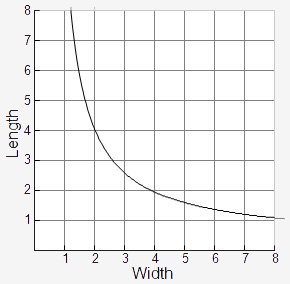This section explores the relationship between the length and width of a rectangle with respect to the area.

Step 1: A rectangle has a width of 1 unit, length of 8 units and an area of 8 square units.
Step 2:
Step 3:
Step 4: Fill in the chart below.
Answer the questions and fill in the blanks below. Move your mouse over the blank to reveal the answer.
- As you increased the width of the rectangle, what happened to the length of the rectangle?
Interactive popup. Assistance may be required.
Check Your Answer
- Multiply the length and width of the rectangle. What do you observe? What is another term for this?
Interactive popup. Assistance may be required.
Check Your Answer
- Use the STAT feature in your graphing calculator, plot the data where x is the width of the rectangle and y is the length of the rectangle. Sketch the graph. Is this an inverse function?
Interactive popup. Assistance may be required.
Check Your Answer
- Find an equation for the graph.
Interactive popup. Assistance may be required.
Check Your Answer
Writing Activity on Inverse Variation
In your notes, write at least three things that you know about inverse variation, include information about tables, graph, equations, etc.




